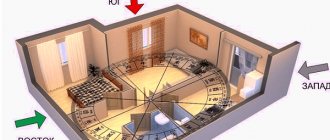Linguistic anthropological studies have shown that most human societies had four points of cardinal direction. The names given to these directions were usually derived from either locally defined geographical objects (e.g., "towards the hills", "towards the sea"), celestial bodies (especially the sun), or atmospheric objects (winds).
According to the chronicler Reinhard (c. 830), the Frankish king Charlemagne coined his own names for the classical winds. He named the four cardinal winds as:
- Nord (etymology uncertain, maybe “wet”).
- Ost (shining place, sunrise).
- Court (solar lands).
- Vest (habitat, meaning evening).
The intermediate winds were constructed as simple composite names of these four. These names are the sources of modern names for compass points, found in almost all modern Western European languages. For example, north, east, south and west in English: Nord, Est, Sud, Ouest.
North, south, west, east: location
The locations of north, east, south and west are called cardinal directions or cardinal points, and are usually designated by the letters, N, E, S, W. East and respectively west are located at right angles to north and south, and east is on a clockwise rotation vector arrow from the north and west directly opposite the east. The points between the directions form compass points. Intermediate (intercardinal or ordinal) directions are northeast, southeast, southwest and northwest. The intermediate direction of each set between the cardinal and cardinal directions is called the secondary - intercardinal direction, which is denoted by:
- NNE.
- ENE.
- ESE, etc.
How to determine feng shui zones in an apartment
As you probably already know, Feng Shui is the science of the proper organization of space... Today we’ll talk about how to organize this very space in a room. So, how to determine Feng Shui zones in an apartment and what is needed for this?
What is needed to define zones?
Firstly, in order to properly organize your space indoors (in an apartment, in a house, in an office, etc.), you need to decide for yourself what area of life you would like to change. For example, move up the career ladder, meet love, etc.
Secondly, when you have decided on the sphere of life, you need to find out where in the house the direction responsible for this sphere is located. Most often in Feng Shui such directions are called sectors or zones.
What feng shui zones exist in an apartment (house)?
According to Feng Shui, there are only 9 zones. Each of them is responsible for one or another aspect of a person’s life and is located in the corresponding direction of the world.
In order not to upset the balance of energies in the house, it is best to activate not one zone, but several. I’m not saying that it’s all 9 at once. Of course not! This will be a clear overkill. Somewhere around 3 zones will be enough (or a little more, it’s up to you). The main thing is to observe the basic principle of Feng Shui - harmony in everything. So that everything fits perfectly, looks beautiful and natural.
According to Feng Shui, all nine aspects of life are interconnected with each other and are combined into the Bagua grid (or there is also the Loshu square).
The Bagua grid is an octagon, each side of which corresponds to a trigram (Bagua is literally translated as “ba” - eight, “gua” - trigram, “ba-gua” - eight trigrams), a cardinal direction, a certain color and one of the five Elements ( Tree, Earth, etc.).
How to determine the feng shui zones in an apartment correctly?
In order to determine where the zones are in an apartment (house) according to Feng Shui, arm yourself with a compass, a floor plan and a Bagua grid (or a Loshu square).
As for the compass, I’ll make a reservation right away. In general, Feng Shui masters use the Lopan compass to determine zones in an apartment. This is a professional compass for a Feng Shui consultant, and not cheap. It consists of a square base, a rotating disk and a magnetized pointer. Lopan has rings on it, inside of which are drawn hieroglyphs and numbers that make up various Feng Shui formulas. Of course, this is a good thing, but for a novice fengshuist or a simple layman, it will be enough to use an ordinary engineering compass.
You can draw the floor plan yourself, or take it from the BTI documents. Only if you do it yourself, draw a plan of the apartment with all the actually existing premises. Don't forget about the bathroom, toilet and storage room.
You can take a Bagua grid or square from the Internet or directly from this article. Just click on the image, it will enlarge, then right click - save as. And print it out.
Now that we have all the tools for determining the Feng Shui zones in the apartment ready, let’s begin the task.
Feng Shui compass – Lopan
Using a compass we determine where north is. Its arrow always points in this direction. When you have found the north, mark it on the apartment plan. Then take the Bagua grid (or the Loshu square) and attach it to the apartment diagram so that north coincides with north. And then, following the markings on Bagua, you can easily find the remaining sectors. As you can see, this is not at all difficult.
A little advice for those who don't have a compass: you can orient yourself to the east. As you know, in the east it rises in the east and sets in the west. Therefore, remember from which side of your apartment or house the sun rises, through which window at dawn the first rays fall - that’s where the east will be. Accordingly, in this direction, attach the Bagua grid to the apartment plan with the same eastern trigram. Next, using the markings, you will determine the remaining Feng Shui zones in your apartment.
So, friends, let's summarize.
Today we talked about:
* what feng shui zones exist?
* in what compass directions are they located?
* what is needed to determine feng shui zones
* how to correctly determine the feng shui zones in an apartment
I hope that the information given will be useful to you, and you will be able to correctly adjust some aspects of your life. Read more about each zone and how to activate them correctly in the following articles.
And finally. Dear readers, if you liked the article, I will be very grateful if you say a kind of “Thank you” by clicking on the social buttons and share interesting information with your friends and acquaintances. Your opinion is important to me and I always enjoy reading your comments on my articles. Leave feedback and this will help make the site even more interesting and useful.
Sun
The position of the Sun in the sky can be used for orientation if the general time of day is known. In the morning the sun rises approximately in the east. In the evening the sun sets approximately in the west. At midday, it is in the south for Northern Hemisphere viewers who live north of the Tropic of Cancer, and in the north for Southern Hemisphere viewers who live south of the Tropic of Capricorn. This method does not work very well when the observer is closer to the equator (i.e. Between the Tropic of Cancer and the Tropic of Capricorn).
Due to the axial tilt of the Earth, regardless of the viewer's location, there are only two days each year when the sun rises due east. These are the days of the equinox. On all other days, depending on the time of year, the sun rises either north or south of true east and falls north or south of true west.
Find a church
Another option to get to the bottom of where the horizon goes is to the west, east... It’s not always exactly correct, but as an auxiliary guide it can complement the picture.
So, if you are in a village or an abandoned village, perhaps you will find a temple there, or rather a church. You need to know that in Orthodox churches the altar will most often face the east. The bell tower will be facing west.
Christian churches are generally aligned from west to east, with the altar at the eastern end of the temple facing the sunrise. Headstones in cemeteries are also usually aligned from west to east.
Astronomy
Astronomy provides a method for finding direction at night. All stars lie on an imaginary celestial sphere . Due to the rotation of the Earth, the celestial sphere rotates around an axis passing through the Earth. This axis intersects the celestial sphere at the north and south poles of the celestial zone, which, according to the observer, lie directly above the north and south, respectively, on the horizon.
In either hemisphere, observations of the night sky show that visible stars move in circular paths caused by the Earth's rotation. This is best seen in long exposure photography. The resulting photograph shows many concentric arcs (parts of perfect circles) from which the exact center can be easily obtained. This center corresponds to the celestial pole, which lies directly above the position of the true pole on the horizon.
The north celestial pole is currently (but not always) within 1 degree of the star called Polaris. The exact position of the pole changes over thousands of years due to the precession of the equinoxes. The North Star is visible only on cloudless nights for residents of the Northern Hemisphere.
While observers in the Northern Hemisphere can use Polaris to locate the North Celestial Pole, the southern star of the constellation Octantus is barely visible to use for navigation. For this reason, the preferred alternative is to use the Southern Cross constellation.
Gyro-compass
At the very end of the 19th century, in response to the development of battleships with large transverse guns that acted on magnetic compasses, and perhaps to avoid the need to wait for good weather at night. In order to accurately check its alignment with true north, a gyrocompass was developed . Because it finds true poles rather than magnetic ones, it is immune to interference from magnetic fields.
Its main drawback is that it relies on technology that many people may find too expensive to be worthwhile outside the context of a large commercial or military operation.
Satellite navigation
At the end of the 20th century, the advent of satellite global positioning systems provided another means of accurately determining true north. Government agencies in charge of satellites constantly monitor and adjust them to maintain their precise alignment with the Earth.
Unlike a gyrocompass, which is most accurate when stationary, a GPS receiver, if it has only one antenna, must move, usually at speeds greater than 0.2 km/h, to correctly display compass directions. On ships and aircraft, receivers are often equipped with two or more antennas separately attached to the vehicle.
Do compasses on smartphones generally show the direction correctly?
In fact, I don’t know a single person who would go mushroom hunting with a smartphone with a compass turned on. Normal people always take a real device with them, and those who know, in addition, take with them a map of the area, matches, a knife and a fully charged phone (in order to call and call rescuers in case of problems, if Network coverage allows).
So, if maps via GPS actually show locations with an accuracy of several meters, then there is a problem with the operation of electronic compasses. Here is an example of how compasses work on two Apple devices: iPhone 6 and iPhone 7:
And who to believe? The settings for both are set to “True North”, yes, the measurements were taken in a room where interference from electronic devices, plus reinforcement and a layer of concrete, has a significant influence, but still the difference on the devices is obvious. The most interesting thing is that the discrepancy with magnetic north on a real compass is from 60 to 120 degrees for both devices.
In general, I honestly wouldn't rely on phone readings in the field. Moreover, this “compass” drains the battery very quickly. A toy, nothing more.
Use of cardinal points for making maps
Thus, with the cardinal points precisely defined, by convention cartographers draw standard maps with north (N) at the top and east (E) at the right . In turn, maps provide a systematic means of recording places, and cardinal directions provide the basis for a structure for locating those places.
In the real world there are six cardinal directions not related to geography, which are north, south, east, west, up and down. In this context, up and down refer to height, or perhaps depth (if water is involved). A topographic map is a special case of cartography in which elevation is indicated on the map, usually through contour lines.
How to calculate cardinal directions without a compass, smartphone and map?
Now that we all have GPS and Google Maps with Yandex.Maps on our phones, which are always with us and ready to serve us at any moment, we have already forgotten many useful techniques that we were taught back in school during geography lessons and which they helped us navigate space so well in any conditions, without maps, without compasses and, of course, without these same smartphones.
And okay, we, those who managed to enjoy a non-synthetic life without the influence of smart phones, all kinds of electronic assistants and all kinds of electronic devices, but the new generation born in the early 2000s and later, unfortunately, did not come into contact with those rules of the game , which were used before the Apple electronic revolution. But even though they were more complex, they could perfectly develop logic and ingenuity in a person, teach intelligence and help in difficult times. Because they were really useful...
But sometimes without knowledge and without your favorite smartphone you simply cannot survive! For example, you are walking in the forest, winter. At some point, you lose sight of the trodden path and realize that you are lost. It doesn’t matter, you reason, and, taking your phone out of your pocket, you try to enter the “maps” application. And suddenly... you realize that your phone is not working. From the word “in general”! The battery is low. What will you do to get your bearings, to find where north, south, west and east are?
Okay, let's not even take such an extreme example, let's say you're just curious about which cardinal directions are located? You cannot pick up a smartphone. Maps and compasses too. What will you do? We will tell you how to act correctly in such a situation.
Here are some strategies that will point you in the right direction, and you will find it solely through your knowledge and not through assistive devices.
Origin of ancient names
During the invasion of the Huns, names from Germanic languages for cardinal directions entered the Romance languages, where they replaced Latin names. Some northerners used Germanic names for intermediate destinations.
In many regions of the world, prevailing winds change direction seasonally, and so many cultures associate specific winds with cardinal and intercardinal directions. For example, classical Greek culture characterized these winds as Anemoi.
In post-medieval Europe, cardinal and intercardinal movements were given names. These often corresponded to the directional winds of the Mediterranean (for example, the southeast was associated with the Sirocco, a wind from the Sahara).











